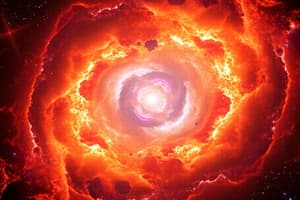Podcast
Questions and Answers
Which event is theorized to have introduced water to Earth?
Which event is theorized to have introduced water to Earth?
- Bombardment by icy meteors from the outer regions of the Solar System. (correct)
- Condensation of water vapor from the Earth's early atmosphere.
- Volcanic eruptions releasing water vapor contained within the Earth's mantle.
- Subduction of hydrated minerals into the Earth's mantle.
The Earth's surface is static and unchanging.
The Earth's surface is static and unchanging.
False (B)
What is the primary source of internal heating within the Earth?
What is the primary source of internal heating within the Earth?
radiogenic heat
According to one hypothesis about the solar system creation a passing star stripped materials from the early sun which then coalesced to form ______.
According to one hypothesis about the solar system creation a passing star stripped materials from the early sun which then coalesced to form ______.
Match the following Cosmological Models with their descriptions:
Match the following Cosmological Models with their descriptions:
What critical role did cyanobacteria play in the early Earth's development?
What critical role did cyanobacteria play in the early Earth's development?
What is the significance of the 'cosmological constant' that Einstein introduced into his theory of relativity?
What is the significance of the 'cosmological constant' that Einstein introduced into his theory of relativity?
Fresh water on Earth is evenly distributed across the planet's surface.
Fresh water on Earth is evenly distributed across the planet's surface.
Flashcards
Infinite Universe
Infinite Universe
Proposed the solar system isn't the universe's center, but one of many.
Cosmological Constant
Cosmological Constant
Einstein's addition to relativity to balance gravity; later rejected.
Expanding Universe
Expanding Universe
Universe originated from a tiny, dense point about 14 billion years ago and is expanding.
Multiverse
Multiverse
Signup and view all the flashcards
Nebular Hypothesis
Nebular Hypothesis
Signup and view all the flashcards
Cyanobacteria
Cyanobacteria
Signup and view all the flashcards
Radiogenic Heat
Radiogenic Heat
Signup and view all the flashcards
Regolith
Regolith
Signup and view all the flashcards
Study Notes
- Sky, land, sea, moon, stars, and every living creature were created in six days.
- The solar system is not the center of the universe but just another star system among an infinite multitude of others (1584).
- The vacuum of space is not empty.
- Cosmological constant was added to the theory of relativity equations by Einstein to counteract gravity's dynamic effects, which would have caused the universe to collapse
- The universe is expanding and originated from an infinitely tiny, infinitely dense point around 14 billion years ago.
- The universe formed from a singularity, first suggested in 1927.
- Albert Einstein favored the model of an expanding universe after rejecting his own original model.
- The general theory of relativity equations of the universe with positive curvature solve the uncertainties of the standard big bang model, such as horizon and flatness problem.
- The universe is just one of many bubbles that grew as part of a multiverse.
- The concept of "many worlds" was popularized in the 1960s and 1970s.
- A rogue star passed close to the sun and stripped materials (hot gases) from both the sun and the rogue star.
- Hot gases continued to spin in the same direction as the sun and coalesced into smaller lumps, forming planets.
- The entire solar system started as a large cloud of gas that contracted due to self-gravity.
- Conservation of angular momentum requires that a rotating disk form with a large concentration at the center, which would start as the proto-sun.
- It began with a fragment from an interstellar cloud composed mainly of hydrogen, helium, and trace amounts of light elements.
- As it contracted, it rotated more rapidly, conserving its angular momentum, eventually evolving into the sun.
- Larger asteroid-sized aggregates formed as accretion continued, orbiting the center of the solar nebula and later becoming planets.
- Cyanobacteria used sunlight, carbon dioxide, and water to produce biomass and oxygen.
- Water came from the icy meteors of the outer regions of the solar system that bombarded Earth.
- Internal heating of Earth is caused by radiogenic heat from radioactive decay of materials in the core and mantle.
- Radiogenic heat is extruded via active tectonic activities, such as volcanism and plate movement.
- Earth's surface is not static but in a constant state of motion.
- Regolith are loose particles of rocks that blanket the surface of Earth.
- 70% of the fresh water is frozen in the form of glacial ice.
- The biosphere includes all life forms and even organic matter that has not yet decomposed.
- The interaction between different subsystems is most dynamic in the biosphere zone.
Studying That Suits You
Use AI to generate personalized quizzes and flashcards to suit your learning preferences.




